Eccentrically yours-
I promised my class in Cincinnati that I would do some writing about eccentric weaving. So this is for you all.
I am not fond of eccentric weaving for so many reasons. Which is the reason that I have written very little  about it in my different books. I will occasionally use it as a very fine eccentric pass if I want the texture of the long loopy look instead of a soumack line note light edges of rose. But, for the most part I find eccentric weaving not appropriate technically and or visually to my designs. I like my designs to lie flat and be the shape that that I create with straight edges
about it in my different books. I will occasionally use it as a very fine eccentric pass if I want the texture of the long loopy look instead of a soumack line note light edges of rose. But, for the most part I find eccentric weaving not appropriate technically and or visually to my designs. I like my designs to lie flat and be the shape that that I create with straight edges . I like to be in control. I never feel in control when I weave eccentrically. With those caveats here are my thoughts about eccentric weaving.
. I like to be in control. I never feel in control when I weave eccentrically. With those caveats here are my thoughts about eccentric weaving.
First a definition- Eccentric weaving and Eccentric passes are woven areas or passes that run up, over and down another shape and then back. 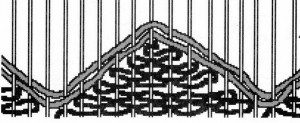 The wefts are not perpendicular to the warp, but move at an angle to the warp, thus they are called eccentric.
The wefts are not perpendicular to the warp, but move at an angle to the warp, thus they are called eccentric.
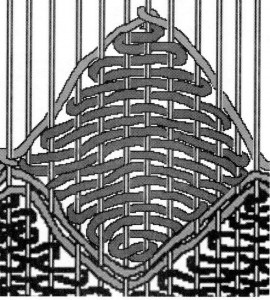 It is not my favourite technique-mainly because it is rarely done well-myself definitely included.
It is not my favourite technique-mainly because it is rarely done well-myself definitely included.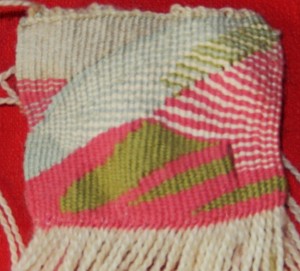 I have very few examp
I have very few examp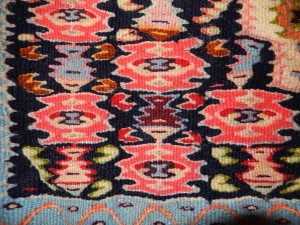 les of things I have woven eccentrically over the last 36 years. When it’s not done well it creates all sorts of tensioning problems, warp distortion, blisters, scalloped edges and wedge weave like constructs. I wish that I had taken pictu
les of things I have woven eccentrically over the last 36 years. When it’s not done well it creates all sorts of tensioning problems, warp distortion, blisters, scalloped edges and wedge weave like constructs. I wish that I had taken pictu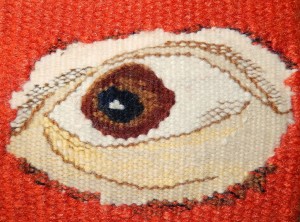 res of
res of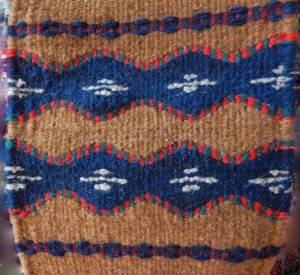 all of the eccentric weaving problems I have seen over the years. I am now looking for examples. These are a few of the ways of using it as raised medallions, a sampler of raised blisters and scalloped edges, Raised dots, zigzag edges, hills and valleys, raised dots, to outline an eye in smaller threads with eccen
all of the eccentric weaving problems I have seen over the years. I am now looking for examples. These are a few of the ways of using it as raised medallions, a sampler of raised blisters and scalloped edges, Raised dots, zigzag edges, hills and valleys, raised dots, to outline an eye in smaller threads with eccen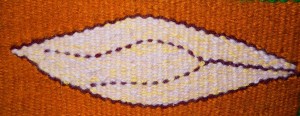 tric hatches,
tric hatches, 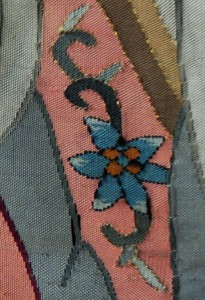 out
out 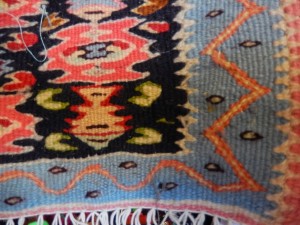 lines a full
lines a full 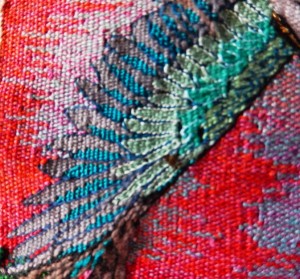 pass and half a pass, outlining flowers with silk and gold threads in kesi, eccentric pick and pick, outlining wings and creating longer weft overs to change texture, just to name a very few.
pass and half a pass, outlining flowers with silk and gold threads in kesi, eccentric pick and pick, outlining wings and creating longer weft overs to change texture, just to name a very few.
| There are some great exceptions of weavers who do it really well-Christine Laffer, Connie Lippert, Silvia Heyden, Michael Rhodee, Shelley Socolofsky( in her last piece-Trade…) to name a few and none of these are beginning weavers. All these weavers have a web presence so Google them or got to pinterest and take a look. What they can do is totally fascinating. |
For some reason
eccentric weaving holds a fascination for beginning weavers who see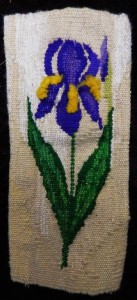 m to like the idea of the long pass that goes over anything in its path. Perhaps it’s just breaking out of the pattern and feels like it’s breaking the “rules.” Interestingly enough to me I found that I had even attempted it in my very first tapestry. What they don’t understands is the inherent problems it can create. An advanced weaver who can control its eccentricities can create incr
m to like the idea of the long pass that goes over anything in its path. Perhaps it’s just breaking out of the pattern and feels like it’s breaking the “rules.” Interestingly enough to me I found that I had even attempted it in my very first tapestry. What they don’t understands is the inherent problems it can create. An advanced weaver who can control its eccentricities can create incr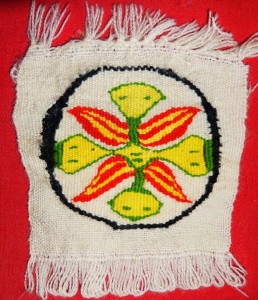 edible shaped tapestries and 3-d weavings or even flat wedge weaves with scalloped edges and imbricated feather like shapes, shapes can used it produce. In Coptic, Turkish, Afghani and Navajo weavings eccentric passes can be used to produce blisters, raised medallions and scalloped edges, and
edible shaped tapestries and 3-d weavings or even flat wedge weaves with scalloped edges and imbricated feather like shapes, shapes can used it produce. In Coptic, Turkish, Afghani and Navajo weavings eccentric passes can be used to produce blisters, raised medallions and scalloped edges, and 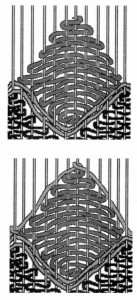 changes in weft structure.
changes in weft structure.
Raised medallions can be made by pulling the eccentric weave at the top and the bottom tighter, but usually the act of beating down on the diamond shape in the middle is enough to pucker the center diamond by tightening the eccentric weaving. The Afghani medallions look flat but are actually blister and rise li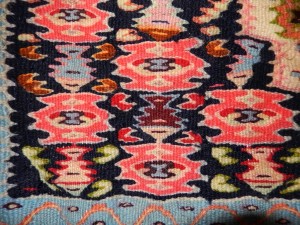 ke small mountains in the center of the salmon pink shapes. At the bottom in the blue the dark dots with white centers are also puckered with eccentric weaving to make them rise a bit from the surface.
ke small mountains in the center of the salmon pink shapes. At the bottom in the blue the dark dots with white centers are also puckered with eccentric weaving to make them rise a bit from the surface.
Wedge weave by using an eccentric line that is tighte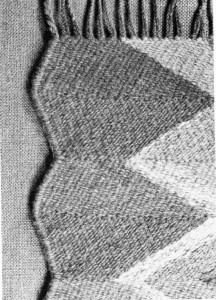 r then the base weaving can also produce a scalloped edge
r then the base weaving can also produce a scalloped edge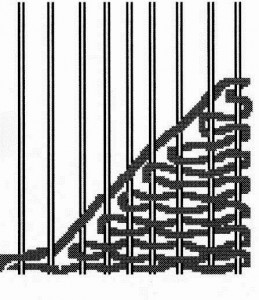 on a tapestry. More complete directions for doing wedge weave are in The Line and Tapestry book that I wrote
on a tapestry. More complete directions for doing wedge weave are in The Line and Tapestry book that I wrote
BUT, Unintentionally,
Usually beginners come to eccentric weaving unintentionally. The problems can be caused by—
A. using too little weft in the bubble over time in a given area or two much weft in another area that forces the warps closer together in another area
B. unequal tension on the warps(loose tension sinks and tighter tension rises because it doesn’t pack down as well as the area of lesser tension
C. turns that pull tighter or looser because when the weft turned around the warp it pulled the half pass it was weaving over tighter.
D. by the way the weft is packed down or beaten unevenly in different places.
E. as the fell line becomes more eccentric the weaver doesn’t correct and the problem or tries to correct it by filling in and pulling the top warps on the eccentric line together tighter because there isn’t enough weft .
The passes along the fell line sink and or rise becoming a form of eccentric weaving as they follow the uneven fell line, OR If the problem isn’t dealt with overtime the problems increase and increase creating havoc as it begins to distort. The warps becoming too close together, or too far apart, massive pull in and/or pullout that may or may not be close to where the original eccentrics are woven and you’re weaving at an angle.
So lets think about how eccentric weaving works. In a perfect world one creates a base of valleys, hills, or an angle. One just weaves across, over and down and continues on weaving- feeling in the valleys and creating more eccentric shapes. Sounds easy! One does this and
One just weaves across, over and down and continues on weaving- feeling in the valleys and creating more eccentric shapes. Sounds easy! One does this and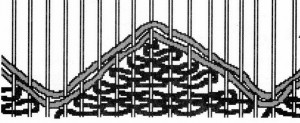 eventually strange things begin to happen-sides pull in for no apparent reason , warps begin to pull out of position or become too close together. The fell line does strange things-dips and rises no matter how hard you try to get it to weave perpendicularly to the warps and fell line. To simplify eccentric weaving can and will cause severe pull in and warp distortion. It’s what it does. The only possible correction is to use a great deal more weft in the weft bundles then used on a normal fell line. If you’re using a 45 degree angle in your bubbles you may need to change that to 75 percent, but in the long run it still may not be enough.
eventually strange things begin to happen-sides pull in for no apparent reason , warps begin to pull out of position or become too close together. The fell line does strange things-dips and rises no matter how hard you try to get it to weave perpendicularly to the warps and fell line. To simplify eccentric weaving can and will cause severe pull in and warp distortion. It’s what it does. The only possible correction is to use a great deal more weft in the weft bundles then used on a normal fell line. If you’re using a 45 degree angle in your bubbles you may need to change that to 75 percent, but in the long run it still may not be enough.
It basically breaks down to cause and effect.
If you don’t have enough weft in the bubble and you weave on top of a 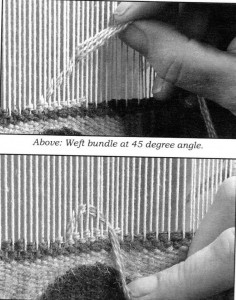 pass the weft has to pull weft from somewhere as weft is beaten down in to the valleys. It takes more weft to weave at an angled then on a straight fell line more the the normal 45 decree angle.
pass the weft has to pull weft from somewhere as weft is beaten down in to the valleys. It takes more weft to weave at an angled then on a straight fell line more the the normal 45 decree angle.
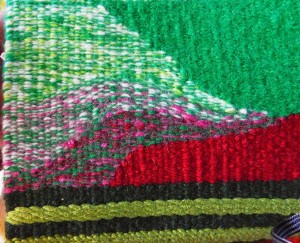 Visually and structurally the further the weft travels between warps the greater the weft length on the surface of the tapestry.
Visually and structurally the further the weft travels between warps the greater the weft length on the surface of the tapestry.
Which will automatically change the look and the hand of the tapestry. Done in fairly large areas the hand of the fabric can be a great deal softer in the eccentric areas and stiffer in the non-eccentric areas.
The eccentric area can create areas that will snag easier. The extra has to come from somewhere. If the extra weft isn’t to be had it gathers up warp and fell line moving everything closer together. Perhaps, If you are experienced enuff to handle this you can control it and make it do what you want it to do and use it as a design element. If not you have a couple of major problems to deal with.
So if you like the look of eccentric lines and shapes these are the possible solutions to making it look good. —
A. more weft in the bubble in the passes.
B. Try not to weave eccentric lines from side to side in one pass. Break up the pass into smaller passes. This will keep the distribution of the weft from being distorted quite so much and controlling smaller areas.
C. use more bobbins that travel less distance along the eccentric fell line. It will still look like single pass, put will have more give and be less likely to pull in at the very edges of the tapestry. Test the line by weaving a few passes on top of the eccentric pass and beat down. Watch for warp distortion and still use more weft in the bubble
D. Instead of using an over and under passes, use dot or line soumack dependin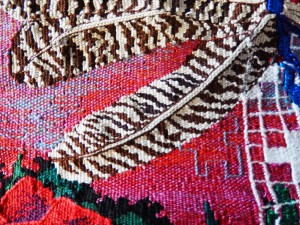 g on the look you want. I would still put a break in the line of soumack every couple of inches just to give the line more give. Mostly this works because the soumack looping doesn’t move up and down the weft-or at least very little and generally the soumack loop only pulls the area around each loop or warp and the stays where put. You still need to make sure to use plenty of weft, because the greater the angle between soumack loops the more weft that is needed between the two warps and wraps.
g on the look you want. I would still put a break in the line of soumack every couple of inches just to give the line more give. Mostly this works because the soumack looping doesn’t move up and down the weft-or at least very little and generally the soumack loop only pulls the area around each loop or warp and the stays where put. You still need to make sure to use plenty of weft, because the greater the angle between soumack loops the more weft that is needed between the two warps and wraps.
E. When all else fails twine and pull the edges out. If you’re in the middle of a piece and you don’t want to take it all out and start fresh before the problem occurred, you can sometimes weave the fell line as flat as possible by filling in. Twine all of the way across the tapestry. Pull out and tie the twining on each side and hopefully the twining will re-space the warps.(see Tapestry 101 page 97)
Short Time solutions for moving and repositioning warps as you weave eccentrically. These are also solutions that can be done slightly eccentrically and always a long a flat fell line to re-space warps.
First trick-Where ever the warps are two tight add extra weft in the bubble then in the area where the warps are too far apart don’t use a bubble. The extra weft will force the warps apart and move into the space where the warps are too far apart. Always do this sooner than later. It’s much easier to fix a problem as soon as you see it happening when it can be correct by one or two passes.
extra weft will force the warps apart and move into the space where the warps are too far apart. Always do this sooner than later. It’s much easier to fix a problem as soon as you see it happening when it can be correct by one or two passes.
Second trick- Whenever possible Fill in sinking areas as quickly as possible with short passes so passes don’t become eccentric and pull at the edges.
3rd trick- Twining can be your friend. You can use it to respace warp or use it to pull out the sides of weaving to where they belong. Twining is a neutral shed like soumack. It doesn’t change the over and under pattern if you weave  over it. No lice to deal with later!(Lice is a play on words about those little annoying white dots that sometimes appear when warps are accidently left exposed in the weaving process.) Twining can be picked out easily when the weaving is finished.
over it. No lice to deal with later!(Lice is a play on words about those little annoying white dots that sometimes appear when warps are accidently left exposed in the weaving process.) Twining can be picked out easily when the weaving is finished.